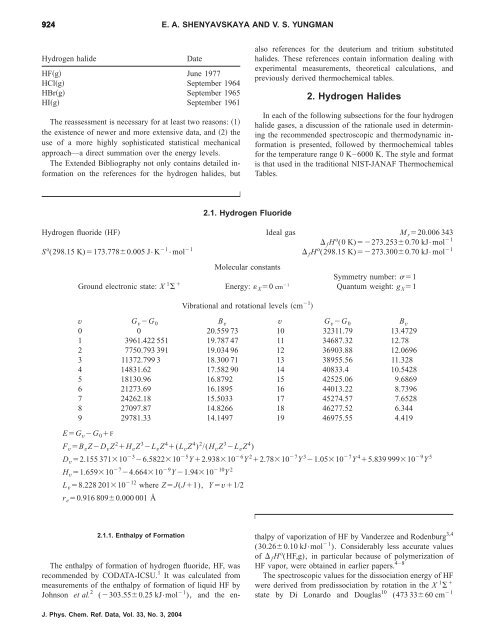NIST-JANAF Thermochemical Tables. III. Diatomic Hydrogen Halide ...
NIST-JANAF Thermochemical Tables. III. Diatomic Hydrogen Halide ...
NIST-JANAF Thermochemical Tables. III. Diatomic Hydrogen Halide ...
You also want an ePaper? Increase the reach of your titles
YUMPU automatically turns print PDFs into web optimized ePapers that Google loves.
924 E. A. SHENYAVSKAYA AND V. S. YUNGMAN<br />
<strong>Hydrogen</strong> halide Date<br />
HFg June 1977<br />
HClg September 1964<br />
HBrg September 1965<br />
HIg September 1961<br />
The reassessment is necessary for at least two reasons: 1<br />
the existence of newer and more extensive data, and 2 the<br />
use of a more highly sophisticated statistical mechanical<br />
approach—a direct summation over the energy levels.<br />
The Extended Bibliography not only contains detailed information<br />
on the references for the hydrogen halides, but<br />
2.1. <strong>Hydrogen</strong> Fluoride<br />
also references for the deuterium and tritium substituted<br />
halides. These references contain information dealing with<br />
experimental measurements, theoretical calculations, and<br />
previously derived thermochemical tables.<br />
2. <strong>Hydrogen</strong> <strong>Halide</strong>s<br />
In each of the following subsections for the four hydrogen<br />
halide gases, a discussion of the rationale used in determining<br />
the recommended spectroscopic and thermodynamic information<br />
is presented, followed by thermochemical tables<br />
for the temperature range 0 K–6000 K. The style and format<br />
is that used in the traditional <strong>NIST</strong>-<strong>JANAF</strong> <strong>Thermochemical</strong><br />
<strong>Tables</strong>.<br />
<strong>Hydrogen</strong> fluoride HF Ideal gas M r20.006 343<br />
fH o (0 K)273.2530.70 kJ•mol 1<br />
S o (298.15 K)173.7780.005 J•K 1 •mol 1 fH o (298.15 K)273.3000.70 kJ•mol 1<br />
Molecular constants<br />
Ground electronic state: X<br />
Symmetry number: 1<br />
1 Energy: X0 cm1 Quantum weight: gX1 Vibrational and rotational levels cm 1 <br />
v G vG 0 B v v G vG 0 B v<br />
0 0 20.559 73 10 32311.79 13.4729<br />
1 3961.422 551 19.787 47 11 34687.32 12.78<br />
2 7750.793 391 19.034 96 12 36903.88 12.0696<br />
3 11372.799 3 18.300 71 13 38955.56 11.328<br />
4 14831.62 17.582 90 14 40833.4 10.5428<br />
5 18130.96 16.8792 15 42525.06 9.6869<br />
6 21273.69 16.1895 16 44013.22 8.7396<br />
7 24262.18 15.5033 17 45274.57 7.6528<br />
8 27097.87 14.8266 18 46277.52 6.344<br />
9 29781.33 14.1497 19 46975.55 4.419<br />
EG vG 0F<br />
FvB vZD vZ 2H vZ 3L vZ 4(L vZ 4 ) 2 /(HvZ 3L vZ 4 )<br />
Dv2.155 3711036.5822105Y 2.938106Y 22.78107Y 31.05107Y 45.839 999109Y 5<br />
H v1.65910 7 4.66410 9 Y 1.9410 10 Y 2<br />
Lv8.228 2011012 where ZJ(J1), Y v1/2<br />
re0.916 8090.000 001 Å<br />
2.1.1. Enthalpy of Formation<br />
The enthalpy of formation of hydrogen fluoride, HF, was<br />
recommended by CODATA-ICSU. 1 It was calculated from<br />
measurements of the enthalpy of formation of liquid HF by<br />
Johnson et al. 2 (303.550.25 kJ•mol 1 ), and the en-<br />
J. Phys. Chem. Ref. Data, Vol. 33, No. 3, 2004<br />
thalpy of vaporization of HF by Vanderzee and Rodenburg 3,4<br />
(30.260.10 kJ•mol1 ). Considerably less accurate values<br />
of fH o (HF,g), in particular because of polymerization of<br />
HF vapor, were obtained in earlier papers. 4–8<br />
The spectroscopic values for the dissociation energy of HF<br />
were derived from predissociation by rotation in the X 1 <br />
state by Di Lonardo and Douglas 10<br />
(473 3360 cm1
















